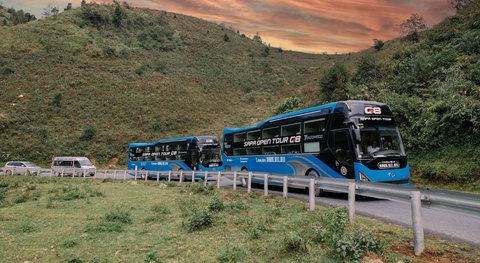|

You have
several good options for getting from Hanoi to Sapa, each
with different levels of comfort, speed, and cost. Since
it's currently June 21, 2025, during summer in Vietnam, it's
a good idea to book in advance, especially for popular times
or if you have specific preferences.
Here's a breakdown of the best ways to travel:
1. Sleeper Bus (Most Popular & Budget-Friendly)
• Journey Time: Approximately 5-7 hours. This can vary
depending on traffic and the number of stops.
• Cost: Generally affordable, ranging from $12 - $22 USD.
VIP cabin buses will be a bit more expensive.
• Comfort: Modern sleeper buses are a comfortable choice for
long journeys. They feature reclining berths (beds), air
conditioning, and often Wi-Fi and USB charging ports. Many
also include blankets and onboard toilets. VIP cabin buses
offer more privacy with individual, enclosed cabins.
• Convenience: Many companies offer direct routes from
Hanoi's Old Quarter (or major bus stations) right into Sapa
town. Overnight buses are very popular as they allow you to
sleep during the journey and wake up in Sapa, saving on
accommodation costs.
• Companies: Reputable companies include Sao Viet, Sapa
Express, EcoSapa, Ha Son Hai Van, G8 Sapa Open Tour, King
Express Bus, and HK Buslines.
• Booking: You can easily book online through platforms like Bookaway, 12go.asia, Klook, or directly on the bus company
websites. You can also book through local travel agencies in
Hanoi.
Pros: Direct, cost-effective, good for overnight travel to
save time and money.
Cons: Can be less private than a train or private car, some
people might find the beds less comfortable for a full
night's sleep.
2. Limousine Van (Comfortable & Faster)
• Journey Time: Approximately 5-6 hours. These vans
typically use the Noi Bai – Lao Cai Expressway.
• Cost: Higher than a regular sleeper bus, usually starting
from $19 - $25+ USD per person.
• Comfort: These are usually 9- to 11-seater vans with
spacious, comfortable leather seats (often with massage
functions), air conditioning, and amenities like Wi-Fi,
bottled water, and charging ports. They offer a more premium
and less crowded experience.
• Convenience: Many limousine services offer hotel pick-up
and drop-off in Hanoi's Old Quarter and Sapa town, providing
a convenient door-to-door service. They usually make 1-2
quick rest stops.
• Companies: Look for services like LuxuryTourVN, Sapaking,
Eco Sapa Limousine, and others that market "D-Car" or
"Limousine VIP" options.
• Booking: Can be booked online through the company
websites, travel agencies, or platforms like Klook.
Pros: Faster than buses or trains, more comfortable and
spacious than standard buses, convenient pick-up/drop-off.
Cons: More expensive than a standard bus, still a shared
ride.
3. Train (Scenic & Traditional, but Requires Transfer)
• Journey Time: Approximately 8-9 hours for the train ride
to Lao Cai, plus an additional 1 hour by bus or taxi from
Lao Cai to Sapa.
• Cost: Varies significantly depending on the class and
private company, generally $20 - $50+ USD.
• Comfort: The train offers a unique, often more relaxed,
and potentially scenic journey. You can choose from various
cabin types: soft seats, hard berths, or soft sleeper berths
in 2-bed or 4-bed cabins. Private tourist train companies
(e.g., Sapaly Express, King Express, Victoria Express, Chapa
Express, Laman Express) offer more luxurious, well-appointed
cabins with better amenities.
• Process:
- Hanoi to Lao Cai: Take an overnight train from Hanoi
Railway Station (120 Le Duan, or specifically the Trần Qu?
C?p entrance for some tourist trains) to Lao Cai Railway
Station.
- Lao Cai to Sapa: From Lao Cai, Sapa is about 30-40 km
away, uphill. You'll need to take a local shuttle bus
(around 40,000-50,000 VND), a shared minivan, or a
taxi/private transfer to reach Sapa town. Buses and taxis
are readily available at the Lao Cai station when trains
arrive.
• Booking: Tickets can be purchased through Vietnam
Railways' official website (dsvn.vn), online booking
platforms (like Baolau, 12go.asia), or travel agencies.
Pros: A classic travel experience, often preferred by those
who get motion sickness on buses, some find it safer, allows
for stretching and walking around more.
Cons: Longer travel time overall due to the transfer in Lao Cai, requires an additional local transfer, usually more
expensive than a sleeper bus.
4. Private Car/Taxi (Fastest & Most Flexible)
• Journey Time: Approximately 4-5 hours, depending on
traffic and how many stops you make.
• Cost: The most expensive option, typically starting from
$100 - $200+ USD per trip, depending on the vehicle size
(4-seater, 7-seater, limousine van).
• Comfort & Convenience: Offers the highest level of privacy
and flexibility. You dictate the schedule, can stop whenever
you wish, and enjoy direct door-to-door service from your
hotel in Hanoi to your accommodation in Sapa. Ideal for
families, groups, or those prioritizing maximum comfort and
convenience.
• Booking: Can be arranged through your hotel in Hanoi,
reputable travel agencies, or private car service providers.
Pros: Fastest, most comfortable, completely flexible
schedule, door-to-door service.
Cons: Most expensive option.
Key Recommendation:
For most travelers, the sleeper bus is the most practical
and popular choice due to its balance of cost-effectiveness,
comfort, and direct service. If you prefer a bit more space
and speed, a limousine van is an excellent upgrade. If you
value the journey itself and don't mind a transfer, the
train offers a classic experience.
No matter which option you choose, book your tickets in
advance, especially for weekend travel or during peak
tourist seasons (which include parts of summer).
|